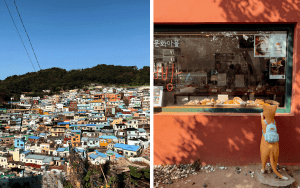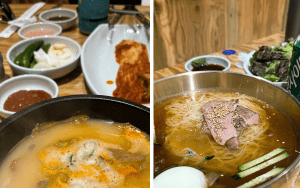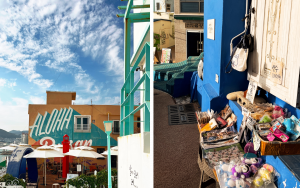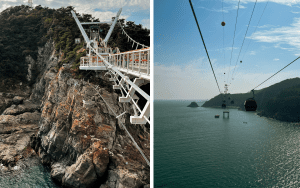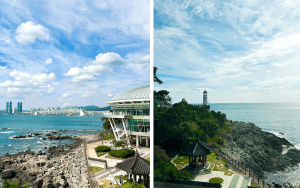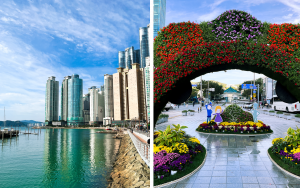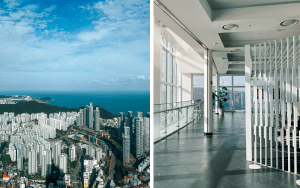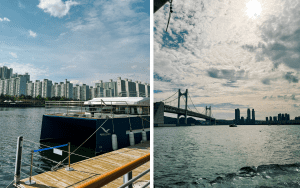Busan is a city of juxtapositions, sandwiching an old world charm with a glossy futurism. Here, nestled between the mountains and the ocean, colourful houses line sloping streets and glass skyscrapers tower over the beaches. On one side of the city, waves crash into rocky coastlines – on the other, they lap gently onto sandy beaches. You can visit a cultural village that teeters on the edge of cliff, or a skyscraper observatory that soars one hundred storeys above the sea.
There’s so much to do in Busan that it might feel hard to know where to begin. But by splitting your time between the east and the west sides, known as the future and the past of the city respectively, you can make the most of your 48 hours in Busan.
Busan makes it easy for you to get around the city, with both a well-serviced and regular bus and subway system in play. You can use these to your advantage, and spend the first 24 of your 48 hours in Busan exploring its storied past.
Gamcheon Cultural Village
There’s a reason that Gamcheon tops every list of must-visits in Busan, and that’s because it’s worth it. Nestled in the mountains, set back from the city centre to the west, Gamcheon is a sprawling village that peppers the hillside with colour.
Created in the 1950s by refugees from the Korean War who were moved away from the port as the city developed, they built backwards and upwards to create a thriving, albeit challenging, mountainside community. Following restorations and development projects, it’s now largely more favoured by visitors than residents, but their amazing handicraft shops make for creative and unique gifts. In addition, buying from official Gamcheon shops throughout sends proceeds directly to continuing preservation funds. As such, it’s now a colourful, vibrant area perfect for exploring – complete with wall murals, winding steps and alleys, and incredible views down towards the port.
Lunch in Chinatown
Though it might sound counterintuitive, you’ll find some amazing traditional Korean food in the city’s Chinatown district – including the speciality of pork rice soup (dwaejigukbab). During the US occupation, the city’s starving North Korean refugee residents foraged in the barracks’ garbage as a last resort. Finding the bones of pork, they were boiled to make a meaty broth and bulked up with rice. Nowadays, it’s served with tender pork, vegetables, salty shrimp, and kimchi, and is worth trying both for its important history as well as its deliciousness. If bone broth isn’t for you, you could always try another delicacy – cold noodles (milmyeon), where a refreshing, icy broth comes filled with veggies, egg, and glassy noodles.
Huinnyeoul Cultural Village
If you’re a keen explorer, it’s possible to visit both Gamcheon and Huinnyeoul in one day, though they’re not especially close. Indeed, there’s something to be said for seeing both, as Huinnyeoul presents a similar story, but instead litters the cliffside rather than the mountains. It’s quieter than Gamcheon, but may well feel busier given the tight alleys you squeeze down, hugging the rock face and the colourful houses built into it.
Named after the area’s historical meandering stream which ran to join the sea, it’s another example of a historic community adapting to the city’s changes, and how has now become a thriving mix of residential and touristic in recent years. Independent coffee shops and craft stores line the narrow promenade, and there’s almost a touch of the Mediterranean about the cliffside houses in parts. There’s also a beautiful blue trail which wraps around the coastline, which is perfect for an aimless wander with a beautiful view.
Songdo Marine Cable Car
Though strictly speaking, the cable car is a modern addition to Busan’s cultural heritage, it’s worth maximising your time on the city’s west side to make sure you get one of the best views of the entire region. After all, who sticks to a theme when they’re travelling?
When you jump on the cable car from Songnim Park, you’re hoisted above the sea as you head over to the Songdo Yonggung Suspension Walkway. En route, you’re treated to some amazing views of turquoise rippling water, vibrant yellow-white sand, and the glint of bright sunlight off of glass windows. You can see across to Huinnyeoul, back to the city, and out to sea – where you’ll see many a boat waiting to gain entry to Korea’s biggest port. It’s by no means a rip-roaring adventure, but it’s a stunning view and a chance for some respite as you rock gently, high above the hobbyist fishermen sitting quietly below.
Gujke Market
One of the most important things you can do in Korea is eat, so make sure you visit the area surrounding the Gukje (Korean for ‘international’) and Kkangtong Markets. In the former, you’ll find locally made goods, crafts, souvenirs, clothing – and even beautiful antiques. In the latter, you’ll find an incredible array of local street vendors selling every staple you’ve ever seen in a tempting video online. From hotteok to tteokbokki, fresh fish to deep fried meat, spending some time here means you’ll leave considerably fuller, and much more content. The best part? Kkangtong is very much an all-nighter, making it a vibrant, neon-lit area to explore once the sun sets.
Across the mighty Gwangan Bridge lies the east side of the city, the perfect place to spend what remains of your 48 hours in Busan. Proudly declared the future of Busan, its rapid development and skyscrapers, must-see attractions, and beautiful beaches mean you can fill your day with the bright and shining modern amenities of Busan.
Dongbaek Island
Start your day with a walk around the peaceful Dongbaek Island, where you can look out to sea and towards the city’s uber-modern beachfront resort area. An island no more thanks to many years of sedimentation, it’s a natural paradise right next to Haeundae beach that provides both stunning views and about 1.5km worth of coastal trails. You’ll find the local power-walkers and joggers out in full force, and as you meander along paths you’ll smell the pine trees, see the beautiful native camellias, and come across local landmarks like the lighthouse lookout station, the mermaid statue perched on the rocks below, and the other-worldly Nurimaru APEC House.
Haeundae
Known as one of the most popular vacation spots in the city, the Haeundae district is the more modern, holiday-friendly area of the east side.
Home to the city’s most famous, sprawling beach with its open, bustling boardwalk, it’s also the perfect place to shop, stock up on all your favourite Korean goods (think K-beauty and skincare galore), and try your hand at fun activities like fish-cake making classes (try Goraesa Eomuk, for example). Despite its more modern, international appeal, Haeundae still retains the spirit of Busan that the west side embues it with, making it a friendly, exciting place to spend some time exploring. There’s museums, bars, restaurants, and galleries all within reach – so grab an ice-cream, take in a spot of shopping, and play the tourist.
Busan X The Sky
Now, if you thought you’d got the most impressive view of Busan from the cable car, you’d be wrong. A cool one hundred storeys atop the Landmark Tower sits the X The Sky observatory. Towering over the city – over the mountains, even – X The Sky gives you the most incredible, floor to ceiling views of the sea from the second tallest building in Korea. While you’re up there, if you can tear your gaze away from the window for a minute, you’ll see that it’s also home to a gallery featuring art from local Korean artists and rotating exhibitions, a sweet letter writing experience for younger visitors, and a delicious grill restaurant on the floor below.
River Cruise
Just across the way from BIFF Square (also worth a visit), you’ll find a small park that leads down to the Suyeonggang River. There’s an unassuming floating dock, and a small metal building declaring that it’s the home of the HAEUNDAE RIVER CRUISE. If you grab a coffee in their outdoor roof café, you’ll soon see a small, modern catamaran pull in, with beanbags lining the front. Swap your shoes for deck-friendly sliders, climb on board, and settle in as you coast from Jwasuyeonggyo bridge out towards the sea. You’ll get views of the riverside park, the Gwangan Bridge, and out towards the city’s remarkable skyscrapers as you swap the millpond river for the marginally more tidal bay.
While it’s a great experience to have at any point of your day, you might want to bring your 48 hours in Busan to a close with a sunset trip. Here, you’ll see the vibrant pinks and oranges of the sky meet the deep blues of the sea, reflected in the east city’s windows as far as the eye can see.
If you’d like to visit Busan as part of a larger tour around Korea, you can see all of our Korea adventures here.
This post is courtesy of:


